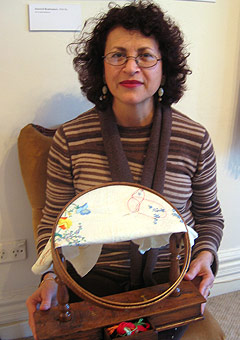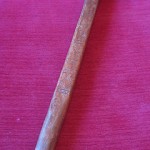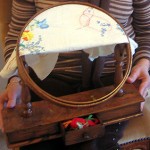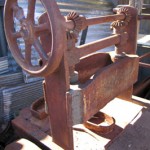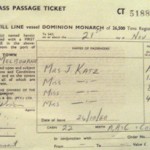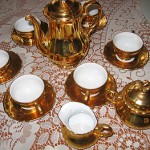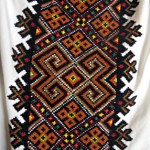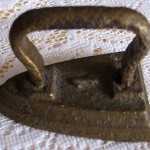(nee D’Ambrozio)
Italian
Gizzeria, Calabria, Italy
Messina, Sicily, Italy on 4 November 1963
Port Melbourne on 3 December 1963
My uncle’s home in Faulkner, Melbourne
I worked at Hanimax, a camera shop in Brookvale, Sydney
I later taught Italian at St Augustine’s College, Brookvale
I was born on 10 May 1949 and was 14 when I came to Australia with my mother Rosa and my sister Sandra who was aged 11. My father, Emilio D’Ambrozio, came to Australia in 1954, nine years before us. In Italy, my parents were contadini (farmers), we owned our own land and were quite self-sufficient. Dad left Italy with his brother Livio and like many young men at the time intended to stay in Australia for two or three years to make their fortune and then come back to Italy as rich men with no further need to work. That was everyone’s dream in those days. My mother agreed because she thought that it would be only for a few years.
All the time that he was away, Dad was desperate for us to join him in Australia, but my mother’s family didn’t want her to leave. They were afraid that they would never see us again. This went on for years and years. Dad used to send us beautiful dresses, handbags, brooches and necklaces and Mum used to dress us all up for the photos to be sent back to him from Australia.
In 1961 my father came back to Italy and Mum didn’t recognise him because he had lost all his hair and he was so tanned from a month at sea. My father was so hurt; he didn’t know what to think. There was a huge struggle between them.
My father promised that he had come home to stay, but after a few months he wanted to return to Australia and said that it was up to my mother if she wanted to come with him or not. Mum still didn’t want to go and ended up asking me, a 12 year old, what I thought. So I actually made the decision for us to return with Dad to Australia. She listened to me. I think she realised how much we had all missed this gentle and kind man.
Dad left for Australia for the second time late 1961 and we joined him in 1963. We left the port of Messina in Sicily on 4 November 1963 and passed through the port of Naples. We had our own cabin and in Naples we were asked by a complete stranger to look after his daughter, Margherita, who was a 17 year old proxy bride who was to meet her new husband in Australia.
My mother packed as many of our belongings as she could and included special things that she had been keeping for our corredo (glory boxes), such as a new cutlery set, hand embroidered sheets, towels and tablecloths. She also brought my embroidery loom that she had had made for me in 1956 when I was eight years old. It was hand crafted by a local carpenter called Tariggi from Gizzeria.
In Italy, school finished up at lunchtime and after school we used to go to a seamstress to learn to sew and embroider. My loom has a little draw for all the cottons. Tariggi must have made it around Christmas time because he had decorated it on the top with Christmas decorations, a bell and a star as well as my initials ‘A.S.’ for Ambrozio Silvana. My mother brought it to Australia because she thought that I would need it here. And I did. I still use it today and it has great sentimental value, it brings me back to the past.
Another special item that my mother packed was a planting tool. It was originally made around 1945 by my grandfather, Domenico d’Ambrosio, from a piece of wood from an olive tree in Calabria. Before my father gave it to my mother, he carved her initials onto it, ‘G.R.’. My mother used it for planting seeds. The pointy part looks new because as it becomes blunt, it has to be sharpened again and again. You hold it like this and make a hole in the ground, put the seeds in and with the other end of it you cover and smooth over with soil.
When we disembarked in Port Melbourne, our uncle Livio took us by car to his house where we stayed for 18 months. I remember our first Christmas in Melbourne, it was melting hot, unbearable. My sister and I started school early in 1964: Sandra at Falkner Primary and me at Falkner High. I had a really hard time at school; my teacher ignored me completely. One boy used to tease me to death because at that time in Melbourne there was a lot of bad publicity about the mafia and a lot of people had been killed. He used to call me ‘mafia, mafia’.
I left Melbourne to come to Sydney in 1970 to marry my husband Michele Toia. I knew him back in our village in Calabria. He was my boyfriend in Italy because he had told a friend of mine that he liked me. He had come to Australia in 1964 to be with his parents and probably to find me.
My family and I first saw Michele at church while on a holiday in Sydney. We were staying in Narraweena in Sydney ‘s north with friends and Michele invited us to see his family’s house in Dee Why. After that meeting, he wrote to me and proposed. My father accepted and I was happy too because I had already built up this relationship in my mind and I felt that Michele was my destiny. My parents were happy because they knew that I was going into a good family.
After we married we stayed with Michele’s family in Mona Vale until we settled into our Mona Vale home. We actually still live on that same block, first in a small wooden house and then later we built a larger brick house. Our two children went to the local Mona Vale public school. Sandra is now 33 and married to Paul and has a baby boy, Alessandro Michele, and Emilia is 30 and lives at home.
My first job in Sydney was at Hanimax, a camera shop in Brookvale. I worked there for 18 months until I was pregnant with Sandra. Michele’s a surveyor, first in Italy and then when he arrived in Sydney he started work at RS Lovegrove Surveyors in 1964. He is still there now 41 years later.
The things that I treasure today also had great sentimental value for my mother. The planting tool was given to me about ten years ago because my mother knew that I loved to preserve history. I will give the embroidery loom and the planting tool to my daughters and then hopefully they will hand them down to their children. It’s our special link with the old country.
September 2012
Ms Silvana Toia died on 6 September 2012, aged 63. The NSW Migration Heritage Centre is grateful for her recollection which has been recorded in Belongings for posterity.


